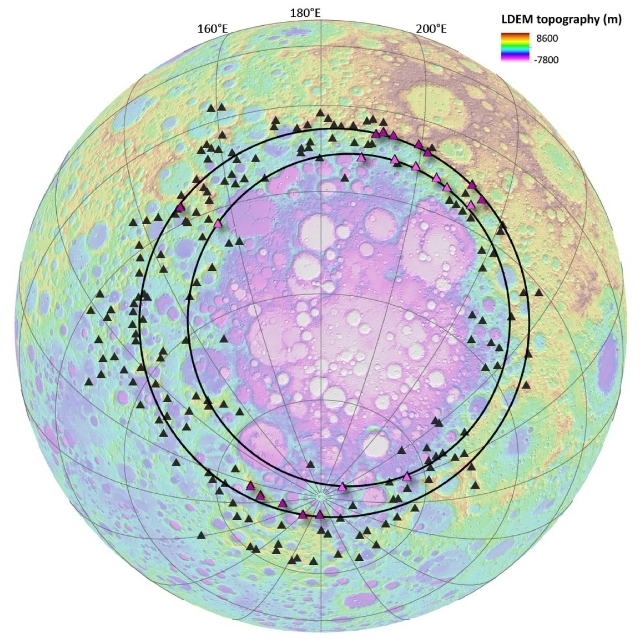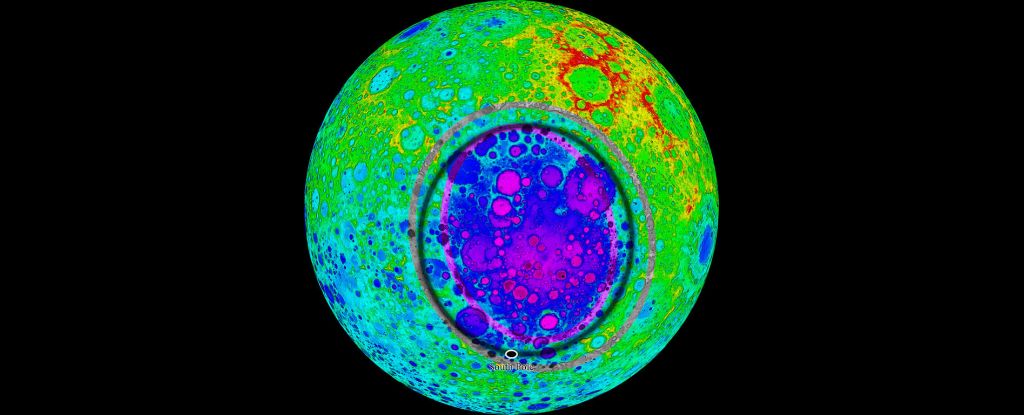Products You May Like
The Moon bears its history on its skin. Earth’s only permanent natural satellite is scored and scarred with billions of years’ worth of cratering – a record of constant bombardment.
The biggest and oldest of these scars is a monster crater, one of the largest, not just on the Moon, but in the entire Solar System. The South Pole-Aitken basin covers nearly a quarter of the Moon’s surface, with a diameter of some 2,500 kilometers (1,550 miles).
It’s not easy to study the South Pole-Aitken basin. It’s over 4 billion years old, and huge; in addition, time and subsequent impacts have done much to obscure it.
But new research suggests that the ancient, gargantuan crater may not have formed the way we thought, and may be much bigger than previous studies suggest – a discovery that has exciting implications for future lunar missions to the basin.
“It’s challenging to study the South Pole-Aitken basin holistically due to its sheer enormousness, which is why scientists are still trying to learn its shape and size,” says geologist Hannes Bernhardt of the University of Maryland.
“Our work challenges many existing ideas about how this massive impact occurred and distributed materials, but we are now a step closer to better understanding the Moon’s early history and evolution over time.”
frameborder=”0″ allow=”accelerometer; autoplay; clipboard-write; encrypted-media; gyroscope; picture-in-picture; web-share” referrerpolicy=”strict-origin-when-cross-origin” allowfullscreen>
Previous work on the South Pole-Aitken basin found that the impact was created by an oblique collision with a large object, leaving behind a crater shaped more like an oval than a circle. Under this model, the debris would have sprayed predominantly in one direction, away from the lunar south pole.
Bernhardt and his colleagues wanted to investigate the way this impact played out by studying the geological features on the surface of the Moon today. NASA’s Lunar Reconnaissance Orbiter has been circling the Moon since 2009, mapping its surface and collecting a wealth of lunar geology data.
The research focused on more than 200 mountain features scattered around the outskirts of the basin that the team thought may be remnants of the crater rim. When the cataloging and the mapping was complete, however, the shape formed by these features was far more circular than the researchers expected it to be.
Impacts gouge out materials from deep under the lunar crust and spray them over the surface. Because the Moon doesn’t experience erosion from geological or atmospheric weather processes that obscure impact evidence here on Earth, those materials should still be there.
“A rounder, more circular shape indicates that an object struck the Moon’s surface at a more vertical angle, possibly similar to dropping a rock straight down onto the ground,” Bernhardt says.
“This circular impact implies that debris from the impact is more equally distributed around it than was originally thought, which means that Artemis astronauts or robots in the south pole region may be able to closely study rocks from deep within the moon’s mantle or crust – materials that are typically impossible for us to access.”

Those materials could give us new insights into how the Moon formed – a process that is shrouded in mystery and the topic of much healthy speculation.
The current leading explanation is that Earth’s satellite is a chunk of planet that broke off during a giant, early Solar System impact, but alternatives include coalescence from a cloud of debris, or gravitational capture.
A more vertical angle of approach for the impactor could explain other strange features of the basin. For example, measurements of the Moon’s gravity around the region suggest that, under the giant crater, the crust of the Moon is much higher density than its surroundings. A possible explanation for this is the presence of a dense chunk of asteroid buried therein.
Having direct access to a treasure trove of minerals from early in the Moon’s history could help answer such questions.
“One of the most exciting implications of our research is how it is applicable to missions to the Moon and beyond,” Bernhardt says.
“Astronauts exploring the lunar south pole might have easier access to ancient lunar materials that could help us understand how the Moon and our Solar System came to be.”
The research has been published in Earth & Planetary Science Letters.
